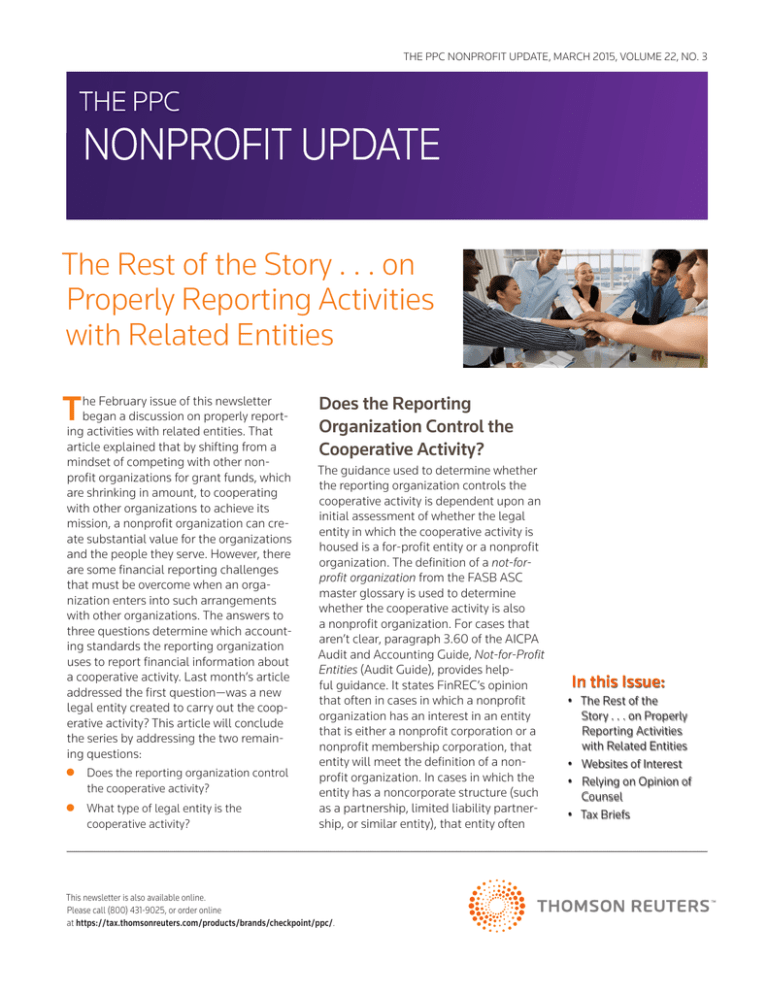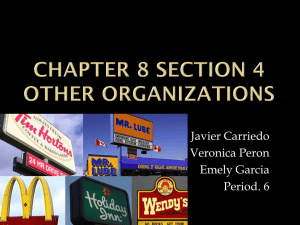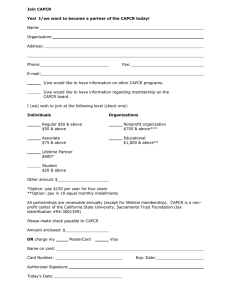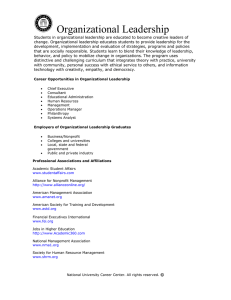
THE PPC NONPROFIT UPDATE, MARCH 2015, VOLUME 22, NO. 3
THE PPC
NONPROFIT UPDATE
The Rest of the Story . . . on
Properly Reporting Activities
with Related Entities
T
he February issue of this newsletter
began a discussion on properly reporting activities with related entities. That
article explained that by shifting from a
mindset of competing with other nonprofit organizations for grant funds, which
are shrinking in amount, to cooperating
with other organizations to achieve its
mission, a nonprofit organization can create substantial value for the organizations
and the people they serve. However, there
are some financial reporting challenges
that must be overcome when an organization enters into such arrangements
with other organizations. The answers to
three questions determine which accounting standards the reporting organization
uses to report financial information about
a cooperative activity. Last month’s article
addressed the first question—was a new
legal entity created to carry out the cooperative activity? This article will conclude
the series by addressing the two remaining questions:
zz Does the reporting organization control
the cooperative activity?
zz What type of legal entity is the
cooperative activity?
Does the Reporting
Organization Control the
Cooperative Activity?
The guidance used to determine whether
the reporting organization controls the
cooperative activity is dependent upon an
initial assessment of whether the legal
entity in which the cooperative activity is
housed is a for-profit entity or a nonprofit
organization. The definition of a not-forprofit organization from the FASB ASC
master glossary is used to determine
whether the cooperative activity is also
a nonprofit organization. For cases that
aren’t clear, paragraph 3.60 of the AICPA
Audit and Accounting Guide, Not-for-Profit
Entities (Audit Guide), provides helpful guidance. It states FinREC’s opinion
that often in cases in which a nonprofit
organization has an interest in an entity
that is either a nonprofit corporation or a
nonprofit membership corporation, that
entity will meet the definition of a nonprofit organization. In cases in which the
entity has a noncorporate structure (such
as a partnership, limited liability partnership, or similar entity), that entity often
This newsletter is also available online.
Please call (800) 431-9025, or order online
at https://tax.thomsonreuters.com/products/brands/checkpoint/ppc/.
In this Issue:
• The Rest of the
Story . . . on Properly
Reporting Activities
with Related Entities
• Websites of Interest
• Relying on Opinion of
Counsel
• Tax Briefs
2 THE PPC NONPROFIT UPDATE, MARCH 2015, VOLUME 22, NO. 3
won’t meet the definition of a nonprofit organization
[either because (a) of the existence of ownership interests;
(b) the entity provides lower costs or other economic benefits directly and proportionally to the owners, members,
or participants; or both (a) and (b)].
Exhibit 3-2 in the Audit Guide contains a chart that
shows where to find the guidance (in the FASB Codification and the Audit Guide) for determining if there is a
control of the cooperative activity. In addition to using
that guidance, the reporting organization also should
consider whether it controls the cooperative activity by
contract. If the cooperative activity is a for-profit entity
and a contractual management agreement has a term
that is either the life of the cooperative activity or a period of ten years or more, the reporting entity should look
to the “Consolidation of Entities Controlled by Contract”
subsections of FASB ASC 810-10 to determine if it has a
controlling financial interest in the cooperative activity. (Although written for physician practice plans, that
guidance is also applicable to other types of entities if
circumstances are similar to those described.) If, instead,
the cooperative activity is a nonprofit organization, a
reporting organization is encouraged to consolidate the
cooperative activity if it controls that cooperative activity
by contract or affiliation agreement and the resulting
financial statements would be meaningful, but consolidation isn’t required.
If the reporting organization is in control or has a controlling financial interest, it consolidates the cooperative
activity unless one of the following circumstances exists:
zz The cooperative activity is in legal reorganization.
zz The cooperative activity is in bankruptcy.
zz The cooperative activity operates under foreign
exchange restrictions, controls, or other
governmentally imposed uncertainties that are so
severe that they cast significant doubt on the reporting
organization’s ability to control the cooperative activity.
zz The rights of the noncontrolling interests are so
restrictive that it’s questionable whether control rests
with the reporting organization.
In addition to those circumstances, there’s one more
exception to the rule that control requires consolidation.
If the cooperative activity is a nonprofit organization and
the reporting organization is neither a sole corporate
member nor the holder of a majority voting interest,
the reporting organization isn’t required to consolidate
the cooperative activity unless it also has an economic
interest in the cooperative activity. An economic interest
exists if any of the following criteria are met:
zz The cooperative activity holds or utilizes significant
resources that must be used for the unrestricted or
restricted purposes of the reporting organization,
either directly or indirectly by producing income or
providing services.
zz The reporting organization is responsible for the
liabilities of the cooperative activity.
A requirement to consolidate precludes reporting an
interest in a cooperative activity at fair value. (The
exception discussed in paragraph 4.30 of the Audit
Guide applies only to investments, not to related entities
that provide goods or services that help the reporting
organization accomplish its mission or serve the reporting organization’s administrative purposes.)
What Type of Legal Entity Is the
Cooperative Activity?
If the cooperative activity isn’t required to be consolidated by the reporting organization, Exhibit 3-2 in the
Audit Guide shows where to find guidance for the noncontrolling interest in the cooperative activity. In general,
noncontrolling interests are reported using the equity
method when the reporting organization has the ability
to influence to a significant degree the operating and
financial policies of the cooperative activity. When the
reporting organization doesn’t have significant influence, the cost method is generally used if the cooperative activity is a for-profit organization and disclosures
only are used if the cooperative activity is a nonprofit
organization.
Alternatively, noncontrolling interests in many types of
entities may be reported at fair value if the organization
makes an election in accordance with the “Fair Value
Option” subsections of FASB ASC 825-10. That election
is typically required to be made when the noncontrolling
interest in the cooperative activity is initially recognized
in the financial statements of the reporting organization.
Illustration
For example, five organizations (an emergency shelter, an organization that assists people with substance
abuse problems, an employment counseling center, a
mental health center, and an agency that assists incarcerated individuals) decide to work together to create
and maintain a database of services provided to the
homeless community. The five organizations create a
nonprofit corporation with each organization appointing one member of the five-member board of directors.
No single organization has a majority voting interest in
the board of directors, so none of the five organizations
controls the new nonprofit corporation. In accordance
with FASB ASC 958-810-25-5, none of the organizations consolidates the new nonprofit corporation. All
THE PPC NONPROFIT UPDATE, MARCH 2015, VOLUME 22, NO. 3 five organizations are required to make the related party
disclosures in FASB ASC 850-10-50-1 through 50-6 as
required by FASB ASC 958-810-50-3.
Conclusion
The benefits of working with another entity to perform
a cooperative activity usually are worth struggling
through the necessary financial reporting challenges.
This series of articles is a simplification of a complex
area—the reporting organization should read the underlying guidance in the FASB ASC and the Audit Guide
and work with its auditors to determine the appropriate
accounting and disclosures.
Practical Consideration:
PPC's Guide to Preparing Nonprofit Financial
Statements devotes an entire chapter to affiliated
organizations and other related entities. To order,
visit tax.thomsonreuters.com/products/brands/
checkpoint/ppc.
• • •
Financial Statement
Preparation
A
s discussed in the December 2014 issue of The PPC
Nonprofit Update, SSARS 21, Statement on Standards for Accounting and Review Services: Clarification
and Recodification, introduced a new financial statement preparation service. Both CPAs and their nonprofit
organization clients may find the financial statement
preparation service attractive, particularly if the nonprofit organization contracts with the CPA to prepare
the organization’s monthly financial statements. Under
the old SSARS, CPAs were required to perform a compilation engagement if they submitted financial statements to their clients. SSARS 21 gives the new option
of the client engaging the CPA to perform a financial
statement preparation engagement instead. There are
pros and cons to the new level of service and CPAs will
want to determine whether (1) the CPA firm will choose
to offer the service and (2) their clients will find that the
service meets their needs.
In order to help CPAs navigate this new type of engagement, Thomson Reuters has developed a new guide,
PPC’s Guide to SSARS Preparation Engagements. That
Guide walks accountants through the rationale behind
3
the new service and some factors to consider when
deciding whether the new service is appropriate for a
firm. Finally, it includes the practice aids needed to
meet the documentation requirements of SSARS 21
for financial statement preparation engagements. For
ordering information, call (800) 431-9025 or go to
tax.thomsonreuters.com.
• • •
Websites of Interest
T
he following websites may be of interest to the nonprofit sector.
www.blueavocado.org
Blue Avocado is a free online magazine sponsored by
American Nonprofits (donations accepted). Launched
in 2008, it has a current subscriber base of 64,000 and
recently published its 100th issue. In celebration of this
milestone, the editors are taking a sabbatical before
returning in the spring of 2015 with a revamped website. But this doesn’t mean that new readers won’t have
content to graze on. Past articles can still be accessed
(see the Editors and Readers Picks and the Our Columns
boxes on the right of the webpage) and, in a few weeks,
the editors plan to post a list of the most-read and highest impact articles in various categories. Each edition
aims to offer at least one thought-provoking or investigative article, at least one practical “how to” article,
and at least one really fun article. Two unique features
of the magazine are its First Person Nonprofit series (in
which board chairs, founders and others tell their story)
and the Ask Rita in HR column where reader-submitted
questions are answered by HR attorneys. Registration
required for commenting. Readers may subscribe to a
free email newsletter.
www.nonprofitcenters.org
The Nonprofit Centers Network (NCN) is a community of
nonprofit and philanthropic leaders who share knowledge and networks to develop and operate high-quality,
shared nonprofit workspace. NCN’s consulting services
can be tailored to fit a variety of budgets and will take
on projects at any stage of the life cycle. The website
offers webinars, trainings, and conferences, in addition
to a Needs Assessment Toolkit to help identify potential partners or tenants in a shared workspace project.
Memberships at various levels are available and are
needed to access premium content.
• • •
4 THE PPC NONPROFIT UPDATE, MARCH 2015, VOLUME 22, NO. 3
Relying on Opinion of
Counsel
D
isqualified persons (DPs) who receive economic
benefits from an organization exempt under IRC
Secs. 501(c)(3), (c)(4), or (c)(29) exceeding the value of
the consideration given for such benefits are subject to
a 25% excise tax on the excess benefit received [IRC Sec.
4958(a)(1)]. Under automatic excess benefit transaction
(EBT) rules, any loan, compensation, or other similar
payment by a Section 509(a)(3) supporting organization to a DP is an EBT; and the excess benefit is the
amount of any grant, loan, compensation, or similar
payment [IRC Sec. 4958(c)(3)(A)].
If a tax is assessed against a DP, any organization manager (manager) who participated in the EBT knowingly,
willfully, and without reasonable cause is subject to a tax
equal to 10% of the excess benefit [IRC Sec. 4958(a)(2)].
When a taxable event is due to reasonable cause (rather
than willful neglect) and is properly corrected, the
first tier tax will not be assessed or, if assessed, will be
abated [IRC Sec. 4962(a)]. First tier tax includes taxes
imposed on EBTs [IRC Sec. 4963(a)].
Definitions
Disqualified Person. The definition of a DP for purposes of an EBT is complex. A DP is—
zz Anyone who was, at any time during the five-year
period ending on the date of the EBT, in a position to
exercise substantial influence over the organization’s
affairs (without regard to whether there is actual
exercise) [IRC Sec. 4958(f)(1)]. Certain individuals are
automatically deemed to have substantial influence
by the nature of their position. These include (1) voting
members of the organization’s governing body; (2) the
president, chief executive officer, or chief operating
officer and anyone who, regardless of title, has or
shares ultimate responsibility for implementing the
decisions of the governing body or for supervising
the organization’s management, administration, or
operation; and (3) the treasurer or chief financial officer
and anyone who, regardless of title, has or shares
ultimate responsibility for managing the organization’s
finances.
The term person includes entities as well as individuals.
For example, a management company that has
ultimate responsibility for managing the affairs of
an organization is a DP because it is in a position to
exercise substantial influence over the organization’s
affairs [Reg. 53.4958-3(g), Ex. 7].
zz A member of the family of individuals described
previously. The members of a person’s family are his
or her spouse (including a same sex spouse), siblings
(whether by whole or half-blood) and their spouses,
ancestors, and direct descendants through greatgrandchildren and spouses of such descendants [IRC
Sec. 4958(f)(4)].
zz An entity (corporation, partnership, limited liability
corporation, trust, or estate) in which a DP and family
members have more than a 35% ownership interest.
Ownership of an entity includes constructive ownership
(i.e., the indirect holdings of family members are
considered) [IRC Sec. 4958(f)(3)].
zz Anyone described previously with respect to a supporting
organization, as defined in IRC Sec. 509(a)(3).
zz A donor (when the transaction involves a donor advised
fund), or any person appointed by the donor, who has
or reasonably expects to have advisory privileges over
the distribution or investment of amounts in the fund
because of the donor’s status as a donor; a member
of such person’s family; and an entity in which these
persons have more than a 35% ownership interest.
zz An investment advisor (when the transaction involves
a public charity that maintains one or more donor
advised funds), a member of his/her family, and a 35%
controlled entity of any of these persons. An investment
advisor is any person (other than an employee of the
sponsoring charity) compensated by the sponsoring
charity for managing the investment of, or providing
investment advice about, assets maintained in the
donor advised funds, including pools of assets, all or
part of which are attributed to donor advised funds
[IRC Sec. 4958(f)(8)(B)].
Manager. A manager is any officer, director, or trustee
of the organization, or one who has powers or responsibilities similar to these [IRC Sec. 4958(f)(2)]. Individuals
who can recommend particular administrative or policy
decisions but cannot implement them without a superior’s approval are not officers. In addition, independent
contractors acting in a capacity as attorneys, accountants, or investment advisors are not deemed officers
[Reg. 53.4958-1(d)(2)(i)].
Participation. A manager’s participation in an EBT
includes both active involvement and silence or inaction
if the person is under a duty to speak or act. However,
managers are not considered to have participated in a
transaction if they opposed it in a manner consistent
with fulfilling their responsibilities to the organization
[Reg. 53.4958-1(d)(3)].
Reasonable Cause. Reasonable cause means that a
manager has exercised ordinary business care and prudence [Reg. 53.4958-1(d)(6)].
THE PPC NONPROFIT UPDATE, MARCH 2015, VOLUME 22, NO. 3 Reliance on Advice of Counsel. Generally, reliance
in good faith on the advice of counsel may establish
reasonable cause that protects a DP or a manager.
The advice must be in a written opinion by legal counsel (including in-house legal counsel) that concludes,
based on a full disclosure of all the facts and the application of existing authorities to such facts, a transaction
is not an EBT. This potential safe harbor also includes a
favorable written opinion by an appropriate professional
when elements of the transaction are within the professional’s expertise. Appropriate professionals include (in
addition to legal counsel) CPAs or accounting firms with
expertise regarding the relevant tax law and independent valuation experts who meet specified requirements
[Reg. 53.4958-1(d)(4)].
A Case in Point
Technical Advice Memorandum (TAM) 201503019
recently elaborated on when reliance on the advice of
counsel may (or may not) establish reasonable cause.
This TAM involved the following parties: C, a public charity by virtue of being a supporting organization under
IRC Sec. 509(a)(3); P, a limited liability company taxed
as a partnership; and X, a former director of C (having
resigned within the five years prior to the mortgage purchase described later) who was also a more-than-35%
owner of P.
C owned a mortgage note that it sold at a public foreclosure sale. P purchased the note with funds borrowed
from C. The loan from C to P was an automatic EBT
under the special EBT rules applicable to supporting
organizations described previously. C filed Form 4720
(Return of Certain Excise Taxes under Chapters 41 and
42 of the Internal Revenue Code) to report the excise
tax on the EBT and to request tax abatement on the
grounds that P reasonably relied upon the erroneous
legal advice of counsel.
Prior to C’s loan to P, C’s legal counsel orally advised
C that neither P nor X were disqualified persons with
respect to C because X was a former board member.
Accordingly, counsel concluded that the loan, which
was designed to benefit C, would not have adverse tax
consequences. Subsequent to the transaction, counsel
acknowledged that this advice was erroneous because
he failed to consider the five-year look back rule in IRC
Sec. 4958(f)(1)(A) for determining who is a disqualified
person and the treatment of loans from a supporting
organization under IRC Sec. 4958(c)(3). Under these
rules, X was a disqualified person with respect to C
because he had been a director of C within the five-year
period ending on the date of the EBT. P was a disqualified person with respect to C because X owned more
5
than a 35% controlling interest in P at the time of the
EBT.
Prerequisites of a Protective Opinion
The technical advice memorandum provides some
insight into protective opinions by examining case history and highlighting why this counsel’s opinion could
not be relied upon.
Erroneous Advice. Reliance in good faith on the advice
of counsel may establish reasonable cause and show
there was no willful neglect where the taxpayer has
obtained advice from a competent tax professional on a
specific tax matter, provided the opinion is based upon
all the relevant information [Haywood Lumber, 38 AFTR
1223 (2nd Cir. 1950)]. A taxpayer may reasonably rely on
the advice of counsel even if the advice given is erroneous [Boyle, 55 AFTR 2d 85-1535 (1985)]. However, reliance on the advice of counsel alone does not establish
reasonable cause—the facts and circumstances must
also support reliance [West Side Tennis Club, 24 AFTR
843 (2nd Cir. 1940)].
Reasonable Reliance. The IRS rejected the request to
abate the EBT tax because P failed to demonstrate that
its reliance on the advice of counsel was reasonable.
Specifically, P did not—
zz Provide information concerning counsel’s expertise on
EBT matters.
zz Prove that it provided all relevant and necessary
information to counsel on which to base his advice.
zz Show that P actually sought the advice of counsel.
(Counsel’s letter did not specifically state who sought
his advice, but it implies that it was C because counsel
advised C that it would be permissible to make the
loan to P.) However, neither counsel nor P provided any
information concerning the circumstances under which
the advice was conveyed to P.
zz Offer evidence indicating that it considered counsel’s
advice (assuming P in fact sought the advice) in
deciding whether to bid on the loan at the public
foreclosure auction.
zz Provide information about the circumstances under
which it sought the advice of counsel (assuming it
did so). The TAM suggests that seeking the advice
of counsel shortly before the consummation of a
transaction might preclude reasonable reliance, unless
there is evidence of extenuating circumstances. For
example, it may have been reasonable to seek advice
on short notice if C’s decision to sell the note was
sudden or if P’s interest in purchasing the note arose
shortly before the auction.
Lessons Learned. The reasoning underlying the IRS’s
refusal to abate the EBT tax in TAM 201503019 provides
6 THE PPC NONPROFIT UPDATE, MARCH 2015, VOLUME 22, NO. 3
The PPC Nonprofit Update is published monthly
by Thomson Reuters/Tax & Accounting, P.O. Box
115008, Carrollton, Texas 75011-5008, (800) 4319025. © 2015 Thomson Reuters/Tax & Accounting.
All Rights Reserved.
Reproduction is prohibited without written permission of the publisher. Not assignable without
consent.
PRSRT STD
U.S. POSTAGE
PAID
Thomson
Tax & Accounting—Checkpoint
P.O. Box 115008
Carrollton, Texas 75011-5008
This publication is designed to provide accurate
information regarding the subject matter covered.
It is sold with the understanding that the publisher
is not engaged in rendering legal, accounting,
investment, or other professional advice. If such
assistance is required, the services of a competent
professional should be sought. Reports on
products or services are intended to be informative
and educational; no advertising or promotional
fees are accepted.
guidelines that should be observed in (1) securing an
opinion of tax counsel on a proposed transaction and
(2) using it as the basis for requesting abatement of an
assessed tax.
First, and most importantly, engage someone who has
in-depth expertise on the tax issue involved. Counsel
must be sufficiently knowledgeable to ask pertinent
questions to uncover potentially determinative facts and
details that the DP or manager may have neglected to
mention.
The request should be written. This will establish who
asked for the opinion and the facts and circumstances
presented to counsel. A written request will also show
when the opinion was sought. Ideally, an opinion should
be requested as early as practical before a proposed
transaction is to be consummated.
Finally, the DP or manager who requests the opinion should, to the extent possible, document that he
or she relied on it in entering into (or approving) the
transaction.
Practical Consideration:
TAM 201503019 makes it clear that a favorable
opinion of counsel does not by itself protect a DP
or a manager from the EBT tax. The party seeking
the opinion must demonstrate that reliance on
it was reasonable in view of all the relevant facts
and circumstances.
• • •
Tax Briefs
LETTER RULINGS: GOOD NEWS, BAD NEWS. Under
new operating guidelines, exempt organizations can
expect private letter rulings to be issued within six
months. The bad news? The IRS’ charge for a private letter ruling is being increased from $10,000 to
$28,300. (Rev. Proc. 2015-1, Sec. 15.05, 2015-1 IRB 1.)
FORM 1023-EZ REVISITED. In the December 2014
issue of The PPC Nonprofit Update Newsletter, we
discussed Form 1023-EZ [Streamlined Application for
Recognition of Exemption Under Section 501(c)(3) of
the Internal Revenue Code] and suggested that such
form may have been too simplified. It appears the IRS
now shares our concern. IRS Chief Counsel William
Wilkins recently stated publicly that Form 1023-EZ is
under “intensive review.” Consequently, it should not be
a surprise if there are changes in the requirements for
using such form.
FINAL RULES FOR SECTION 501(c)(29) EXEMPT
STATUS. Qualified nonprofit health insurance issuers
may be tax exempt under IRC Sec. 501(c)(29). Treasury recently released final regulations (TD 9709) that
authorize the IRS to prescribe the procedures by which
these entities can apply for recognition of exempt status.
The IRS had previously issued Rev. Proc. 2012-11, 2012-7
IRB 368 that explained how an organization should
apply for exemption (based on authorization in the temporary regulations). The IRS now intends to reissue Rev.
Proc. 2012-11 with a 2015 designation under the authority of the final regulations.
• • •



